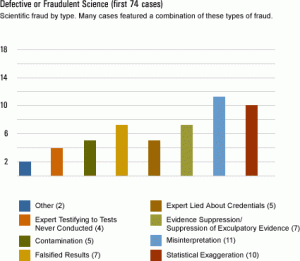When forensic evidence is presented in the courtroom, there is a general assumption that “if it is scientific, then it must be true.” The reality is much different. Witnesses in white lab coats are much easier to believe than the defendant who has already been stigmatized simply by being charged. Most jurors are inclined to believe that the defendant “must have done something” or “Why would The State bring the issue to court?”
Attorneys Brandon Garrett and Peter Neufeld from The Innocence Project conducted a thorough case study of persons who were wrongfully convicted due to invalid forensic evidence and later exonerated by DNA evidence. They found that in those wrongful conviction cases 60% of forensic scientist testimony was invalid, thus leading to a wrong probability of the accused of actually having committed the crime for which they were sent to prison.

Let’s dissect the issue further. At the scene of the crime, among other evidence, detectives collect forensic evidence such as blood stains, hair pieces, shoe prints, which are submitted for lab analysis. In court, forensic scientists will explain the results according to their expert opinion. As a result, the defendant may be found guilty. Types of forensic evidence commonly presented at criminal trials:
1. Serological Analysis (Blood Typing)
2. DNA testing
3. Hair Microscopy
4. Fingerprinting
5. Bite Mark, Shoe Print, Fiber, Soil Comparisons
5. Firearm Tool Mark Analysis
The first 2, blood typing and DNA testing, do have proper scientific testing techniques. But sometimes these tests are conducted improperly or the results are conveyed inaccurately or improperly on the trial stand by the scientist. Knowing that 38% of Americans have type O positive blood, is that conclusive evidence of the guilt of a defendant who also has type O positive blood like that found at the scene of the crime?
Regarding other forensic testing such as bite mark or shoe comparisons, the lab techniques have not be subjected to sufficient scientific evaluation. In fact, back in 1995, a federal judge ruled microscopic hair comparison testimony to be too scientifically unreliable.
What the Innocence Project study concluded was that in many cases, the science, rather than the scientist, is inadequate. And yes, in this imperfect criminal justice system, forensic analysts have engaged in misconduct like fabricating or concealing parts of the results. This was proven by later DNA testing results which exonerated those who were wrongfully convicted.
Take for example the case of Annie Dookhan, the state’s drug chemist in Boston who falsified the results in nearly 34,000 cases.
Stay tuned for part 4 in this series “Police and Prosecutorial Misconduct.”
Read more at
http://www.innocenceproject.org/causes/unvalidated-or-improper-forensic-science/